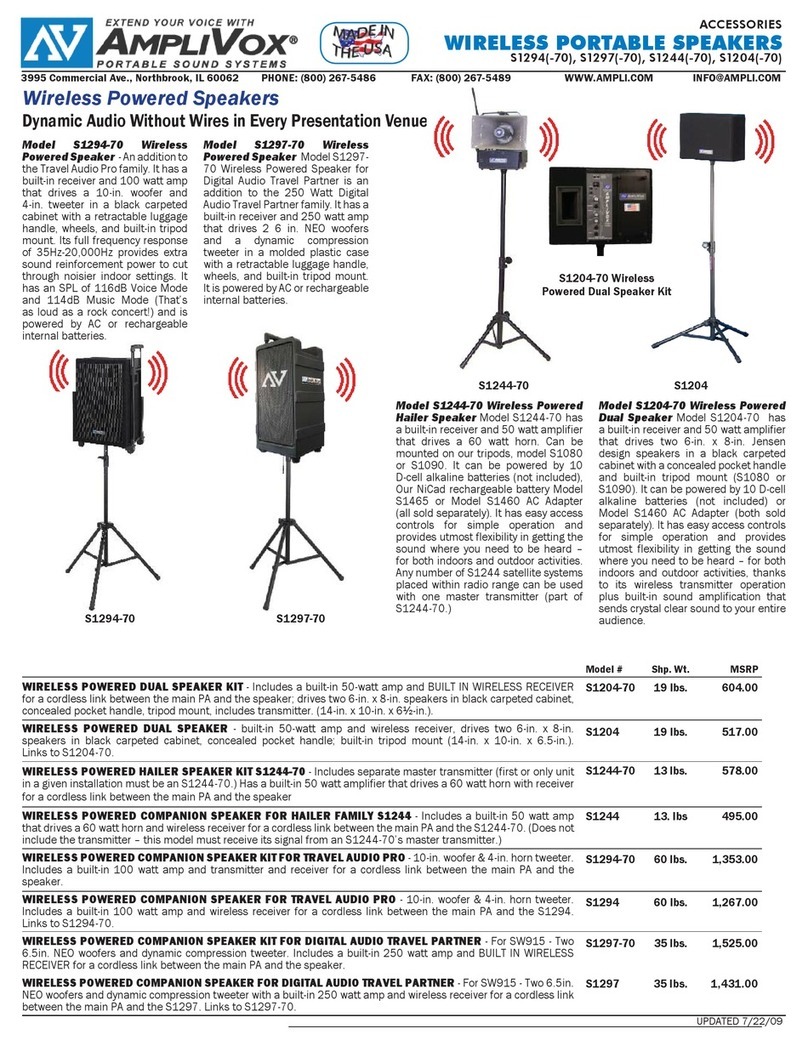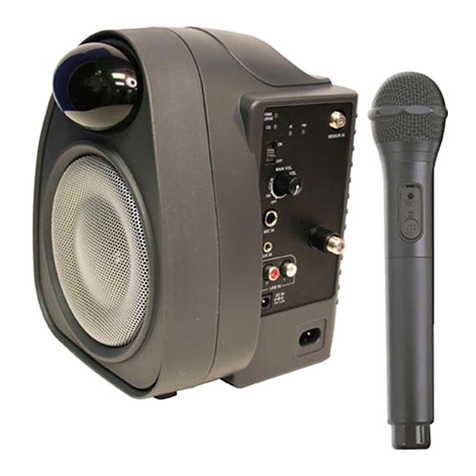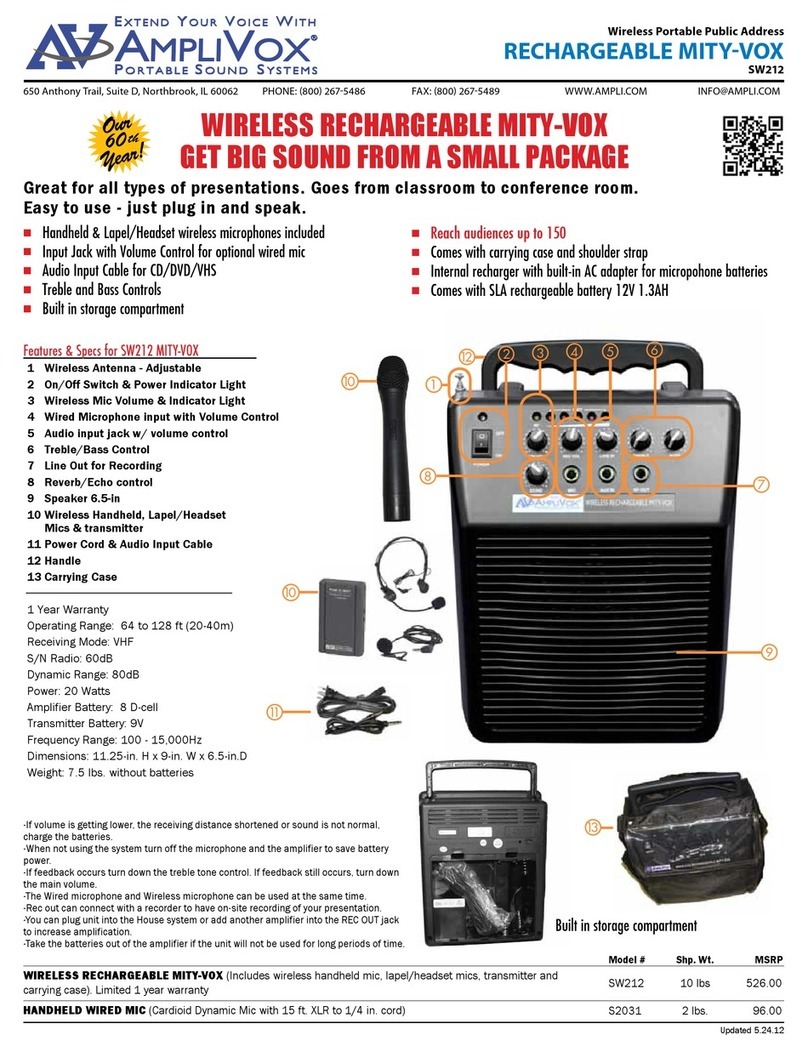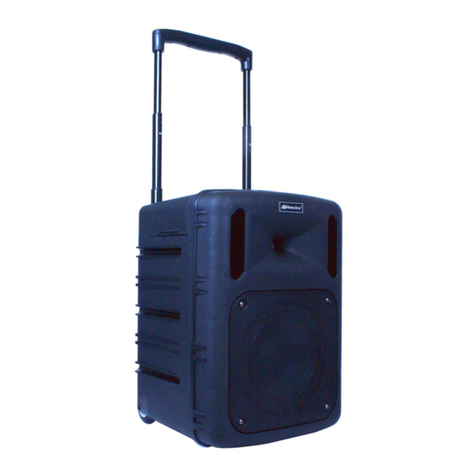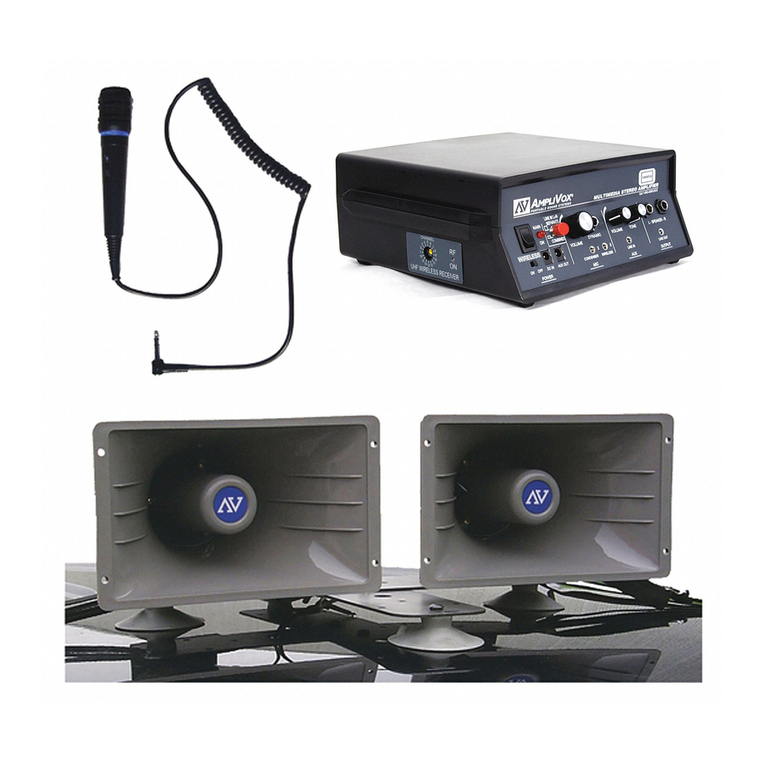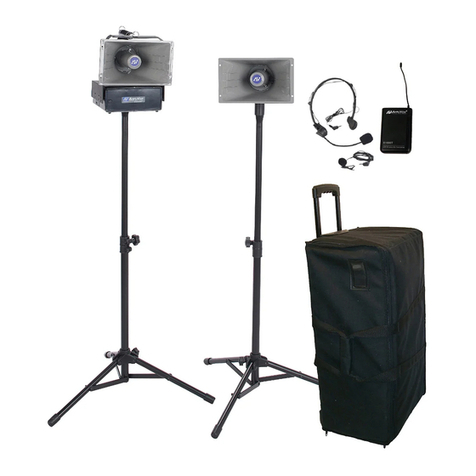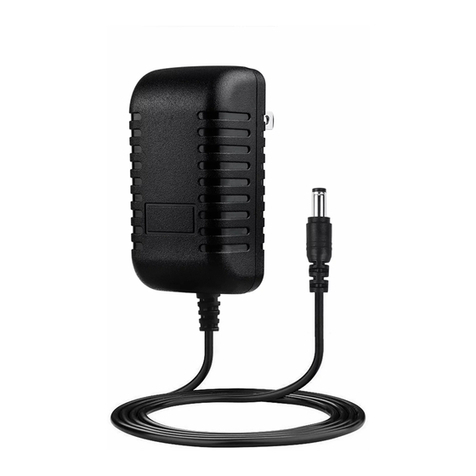8
SW915 DIGITAL AUDIO TRAVEL PARTNER 5SW915 DIGITAL AUDIO TRAVEL PARTNER
wireless microphone setup and operation
We use only the best wireless microphones for our PA systems. Audio-
Technica’s 700 Series Freeway wireless delivers professional features
and sound quality unheard of in its class. These easy-to-use wireless
systems feature eight selectable frequency-coordinated channels,
diversity operation for increased range/reliability, automatic frequency
scanning, Tone Lock™ squelch and more. For multiple-mic applications,
as many as eight systems may be used together.
trAnsmitter setup, controls And functions
BATTERY SELECTION:
Two 1.5V AA type alkaline batteries
BELT PACK Transmitter Battery Installation:
1. Open the transmitter door by first pulling the catch down and then
sliding the door upward.
2. Observe correct polarity as marked and carefully insert two fresh
1.5V AA alkaline batteries.
3. Slide the door closed making certain it clicks securely in place.
HANDHELD Wireless Microphone Battery Installation:
Power /Mute Battery Indicator:
After the battery is installed, press and hold the power button unit until
the battery indicator LED turns green (it will first turn red, keep holding
until it turns green). If the battery indicator LED does not light up when
the power button is pressed, the batteries are installed incorrectly or
they are dead. The LED will flash to indicate low-battery condition. Press
and hold power button to shut unit off (light shuts off).
Mute Function:
With the transmitter on, a slight touch of the Power/Mute button will
toggle between muted and live operation. Red led indicates muted
operation, Green LED indicated live operation.
RECEIVER CONTROLS AND FUNCTIONS
THE POWER SWITCH ON THE HANDHELD MICROPHONE IS BUILT
INTO THE POWER/MUTE/BATTERY BUTTON, WHICH IS LOCATED ON
THE BASE OF THE MICROPHONE.
1. Unscrew the lower body cover slide it downward, and remove it to
expose the battery compartment.
2. Observe correct polarity as marked inside the battery compartment
and carefully insert two fresh 1.5V AA alkaline batteries. Insert the
first battery and slide it toward the spring contact. Then insert the
second battery into the space remaining. Make certain the batteries
are fully seated in the battery compartment.
3. Slide the lower body compartment back on and screw the housing
together. Do not over tighten.
Note: Remove batteries from the handheld transmitter starting at the
bottom end, where finger indents in the battery housing are provided
for easy grip.
1 2 3 4 5
ANTENNAS: Are positioned internally at the optimal 45 degree angle for
best reception.
1 - AF PEAK INDICATOR: Indicates when maximum transmitter
modulation without distortion has been reached. Not affected by
position of Volume control (Fig. C).
2 - LED WINDOW: LED Display indicates channel setting and scanning
operation.
3 - DIVERSITY INDICATORS: Indicates which antenna (A or B) has better
reception and is in operation.
4 - SELECT BUTTON (for manual channel selection): Press the Select
button repeatedly until desired channel is reached. Press and hold the
Set/Scan button to manually set the receiver to indicated channel.
Channel number will stop flashing. (A brief touch of the Set/Scan button
will revert to previously set channel). If the Set button is not pressed
within 10 seconds to confirm the selection, the system will revert to its
original channel.
5 - SET/SCAN BUTTON: The Set/Scan button can be used in two ways:
1) in conjunction with the Select button to permit manual selection
of an operating channel in Manual Set Mode (see “Select button”
description above); and 2) Automatic Scan/Set Mode, to initiate the
automatic channel scan and selection, as follows: Automatic Scan/Set
Mode: Press and hold the Set/Scan button for about two seconds. The
current channel will flash three times quickly; then the system will begin
to scan for the next open channel. When it finds an open channel, it
will flash the open channel three times and then set the channel. (If an
open channel is not found, the automatic scan will return to the original
channel and flash 5 times.)
inputs and outputs:
microphone/instrument inputs:
There are 3 types of input jacks on your DIGITAL AUDIO TRAVEL
PARTNER, as follows:
2 – 1/8” phone jacks (3.5 mm)
2 – RCA jacks
3 – XLR or ¼” combination jacks (this jack will accept either type)
There are two types of microphones the DIGITAL AUDIO TRAVEL PARTNER
is designed for Dynamic - for standard dynamic cartridge microphones
Condenser - for electret or condenser microphones, which require
phantom power (supplied from the amplifier)
There are three microphone channels (Channel 1, Channel 2, and
Channel 3), and each channel has individual volume controls. Each
channel will accept any of the listed microphone types, but only one
microphone or instrument should be plugged into each channel at a
time.
Add pre-recorded music to your presentations with the internal CD or
tape player. Channel 3 Volume Control adjusts the volume for these
units. In addition, an external source such as a computer or MP3 player
can be used by connecting to jack(s) on any available channel.
record/line out:
This jack provides the output of the mixer. To record or connect to a
house PA system, external equalizer, audio mixer, or transmitter of
AmpliVox S1294 wireless powered companion speaker, connect the
LINE OUT on the amplifier, to the input on an external recorder or PA
system. This jack functions the same as a signal “send”. (See Special
Features Section)
usb interfAce
When a computer is connected through the USB interface, the audio
portion of any multimedia programs (such as PowerPoint, Windows
Media Player, etc.) used on the computer will be heard on the 915. The
volume and tone controls in the computer program will determine the
loudness and sound characteristics of what’s heard from the computer
program through the 915.
line insert:
Use this jack to supply a signal directly to the power amp. This jack
functions as a signal “return”. Doing so will disconnect the mixer section
of the DIGITAL AUDIO TRAVEL PARTNER and act as a power amplifier.
See the “Special Features” section for more details. This is the input to
use for the return signal from the Output of the Equalizer, Audio Mixer or
other type of audio equipment connected in the paragraph above. (See
Special Features Section)
Mixer stage – includes all the individual volume controls, input
jacks (14”-XLR combo, 3.5mm, RCA) and mic/line & phantom power
switches for the 5 input channels (2 internal wireless, 3 direct or
corded) ‘Record/Line Out’ and ‘Line Insert’ stage – see below.
Output stage - includes the music/voice switch, treble, bass & master
volume controls, power amps and speakers.
The DIGITAL AUDIO TRAVEL PARTNER panel has ¼” phone jacks
labeled ‘Record/Line Out’ and ‘Line Insert’ respectively. ‘Record/Line
Out’ provides a feed from the Mixer stage, but before this signal goes
through the Output stage. In other words, this signal is not affected
by settings on the music/voice switch, treble, bass & master volume
controls. It can be used to drive an external recording device or
another audio system. The advantage to this configuration (pre-EQ
& master volume) is that the external system’s own EQ & volume
settings can be separately adjusted to suit its environment
and the two systems do not interact with each other.
The ‘Line Insert’ jack works in two ways. When no plug is inserted it
internally connects the Mixer to the Output. However, when a plug
is inserted it disconnects the Mixer from the Output, replacing it
with the external audio signal from the device the plug’s cable is
attached to. In this configuration, the DIGITAL AUDIO TRAVEL PARTNER
Output stage can be used to amplify a feed from an external mixer or
playback device. For instance, assume a facility’s main meeting room
has a built-in sound system, but the adjoining room for the overflow
crowd has no system. A ‘Line Out’ feed from the house system could
be plugged into the ‘Line Insert’ jack of a DIGITAL AUDIO TRAVEL
PARTNER located in the overflow room. The DIGITAL AUDIO TRAVEL
PARTNER’s EQ & master volume can then be adjusted to suit the
overflow room’s conditions without any effect on the main system.
The other way this pair of jacks can be used is to insert an external
device such as a graphic equalizer, echo/reverb machine or other
audio processing device between the Mixer and Output stages of
the DIGITAL AUDIO TRAVEL PARTNER. The ‘Record/Line Out’ on the
‘905 connects to the ‘Line In’ of the external device and its ‘Line
Out’ connects to the ‘905 ‘Line Insert’. Remember from the above
discussion that a plug in the ‘Line Insert jack breaks the direct internal
connection from the Mixer so in effect the external device is electrically
inserted between the 2 stages and becomes a functional block of the
DIGITAL AUDIO TRAVEL PARTNER.
fuses
There are two circuit protection devices that are user serviceable. The
25A circuit breaker protects the power supply and battery circuits.
Press to reset.
There is also a fuse in the AC jack. It is identified on the plastic with
a drawing of a fuse. ***DETACH THE AC CORD FROM THE UNIT
BEFORE FUSE REPLACEMENT*** This fuse protects the AC circuitry.
Use a flat blade screwdriver in the slot on the top of fuse holder to
slide the fuse holder out. Replace the fuse with a 10A/250V fuse if
needed. If after resetting and replacing the breaker and fuse , the
SW915 Digital Audio Travel Partner does not “power on”, please call
AmpliVox Customer Service at 800-267-5486.
wArninG! risk of shock! do not open unit no user
serviceAble pArts inside!


